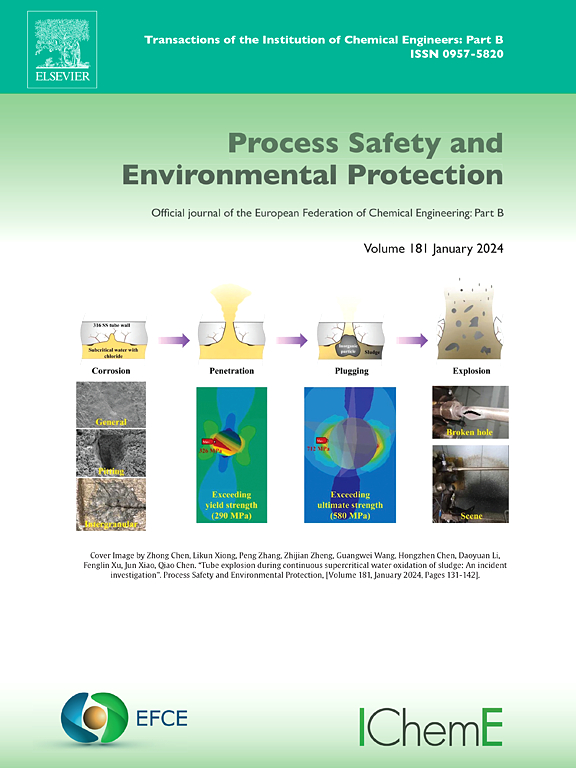用cao包覆焦炭提高烧结燃料的低氧燃烧反应性:准颗粒热重分析和烧结罐实验的启示
IF 6.9
2区 环境科学与生态学
Q1 ENGINEERING, CHEMICAL
引用次数: 0
摘要
高比例的烟气再循环降低了含氧量,影响烧结生产。为了解决低氧条件下的燃烧抑制问题,本研究考察了准颗粒结构对低氧环境下燃烧特性的影响。采用非等温和等温热重实验对一维准颗粒的燃烧特性进行了定量分析。在o2浓度为15 %的条件下,cao包覆焦炭的反应性指数和反应速率常数分别比纯焦炭提高了26.6 %和15 %。随后的研究表明,cao涂层增加了活性位点的数量,扩展了燃烧产物的扩散路径,显著增强了催化燃烧效果。利用这些发现提出了CaO预混低氧烧结方案。通过烧结罐实验,研究了二维离散燃料低氧烧结对生产指标的影响。实验结果表明,CaO预混可使垂直烧结速度提高6.33 %,生产率提高5.45 %。此外,表层的熔化时间延长了50 %,导致产量提高12.6 %,滚筒强度提高1.9 %。本研究证实CaO预混在15 % O2时满足生产要求,为提高烧结烟气再循环率提供了数据依据。本文章由计算机程序翻译,如有差异,请以英文原文为准。
Enhancing low-oxygen combustion reactivity in sintering fuels using CaO-coated coke: Insights from quasi-particle TGA and sintering pot experiment
High proportion flue gas recirculation reduces oxygen content, affecting sintering production. To address combustion inhibition under low oxygen conditions, this study examines the impact of quasi-particle structure on combustion characteristics in hypoxic environments. The combustion characteristics of one-dimensional quasi-particles were quantitatively analyzed using non-isothermal and isothermal thermogravimetric experiments. The reactivity index and reaction rate constant of CaO-coated coke increased by 26.6 % and 15 %, respectively, compared to pure coke under 15 % O₂ conditions. Subsequent studies have shown that CaO-coating increases the number of active sites and extends the diffusion path of combustion products, significantly enhancing the catalytic combustion effect. These findings were used to propose a CaO premixed low-oxygen sintering scheme. The effect of low-oxygen sintering of two-dimensional discrete fuels on production indexes was investigated by sintering pot experiments. Experimental results indicate that CaO premixing increases vertical sintering speed by 6.33 %, enhancing productivity by 5.45 %. Furthermore, the melting time of the surface layer is prolonged by 50 %, leading to a 12.6 % yield increase and a 1.9 % improvement in drum strength. This study confirms that CaO premixing meets production requirements at 15 % O2, thus providing data basis for improvements in the sinter flue gas recirculation rate.
求助全文
通过发布文献求助,成功后即可免费获取论文全文。
去求助
来源期刊

Process Safety and Environmental Protection
环境科学-工程:化工
CiteScore
11.40
自引率
15.40%
发文量
929
审稿时长
8.0 months
期刊介绍:
The Process Safety and Environmental Protection (PSEP) journal is a leading international publication that focuses on the publication of high-quality, original research papers in the field of engineering, specifically those related to the safety of industrial processes and environmental protection. The journal encourages submissions that present new developments in safety and environmental aspects, particularly those that show how research findings can be applied in process engineering design and practice.
PSEP is particularly interested in research that brings fresh perspectives to established engineering principles, identifies unsolved problems, or suggests directions for future research. The journal also values contributions that push the boundaries of traditional engineering and welcomes multidisciplinary papers.
PSEP's articles are abstracted and indexed by a range of databases and services, which helps to ensure that the journal's research is accessible and recognized in the academic and professional communities. These databases include ANTE, Chemical Abstracts, Chemical Hazards in Industry, Current Contents, Elsevier Engineering Information database, Pascal Francis, Web of Science, Scopus, Engineering Information Database EnCompass LIT (Elsevier), and INSPEC. This wide coverage facilitates the dissemination of the journal's content to a global audience interested in process safety and environmental engineering.
 求助内容:
求助内容: 应助结果提醒方式:
应助结果提醒方式:


